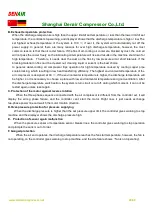
Shanghai Denair Compressor Co.,Ltd.
www.denaircompressor.net 31/48
Two. System flow
A. Air flow
After eliminating dust by air filter, the air will be compressed in the air end compressing chamber via inlet valve
and mixed with lubricating oil. The compressed compound air enters the oil-gas tank to be primarily separated, and
after the first separation, the compound air will enter the after-cooler via minimum pressure valve after precision
separation in the precision oil-gas separating core, and at last, it enters the air supply pipeline through outlet valve.
B. Main Parts Function Instruction
a.Air Filter
In general, we should clear the dust on the surface of air filter every 1000 hours, and the method is to blow down the
dust from inside to outside.
b. Air Inlet Valve
Empty load\overload control
The air inlet valve adopts piston control and uses the up-down action of the piston to do the empty load and
overload control. When starting, stopping or empty, it all uses the two-way solenoid valve action to control the air
inlet valve piston and up close valve. Meanwhile, it also applies throttling valve to keep the minimum pressure
needed by the system circulation. After the motor full-load operation, the two-way solenoid valve gets electricity and
stops discharging, during which time, the air inlet piston are sucked down to be the air inletting state because of air
inlet pressure difference. If the pressure reaches the upper limit valve of pressure switch, the pressure switch will act,
and the two-way solenoid valve begins to discharge and pushes up the air inlet piston to close the valve and
become empty load state.
Volume adjusting control: 15—37KW
When the system pressure rises gradually (not reach the set value of pressure switch), it first reaches the set
pressure of the volume adjusting valve, and a little air pass through to push the air inlet valve piston upwards, and
then the air inflow will decrease gradually, during which time, the system has begun to adjust the volume. If the
pressure continues to rise, the air inlet piston will go up and close down, and on the contrary, if the system pressure
lowers down, the air inflow will be more when starting the air inlet valve. The volume adjusting working will stop
when it is lower than the set valve of volume adjusting valve.
Guide bar empty volume control valves
:
45—250KW
The air inlet valve has two brakes on the right and left. The left one is air inlet brake while the right one is volume
adjusting brake. When it is overload, the pressure from solenoid valve enters the left pneumatic cylinder. Because of
different exposing pressure area, the valve rod will be pushed to the right, and at the moment, the air inlet valve
opens and operates at overload state.
There is a branch pipe of the system pressure connected to the entrance of the right pressure control valve
through the volume adjusting valve and enters the volume adjusting control chamber. When the system pressure
rise because of decreasing usage amount and reach the set pressure of the volume adjusting valve, the pressure
begins to enter the volume adjusting control chamber. There is a discharge hole in the volume adjusting control
chamber, and if the air inflow more than that of air discharging, the volume adjusting control chamber will produce
pressure gradually, and the diaphragm push the valve rod leftward under pressure to limit the air inflow. If the
system air usage amount increasing, the system pressure will decrease a little, and the volume adjusting valve close
down or turndown, during which time, the pressure resource of volume adjusting control chamber will decrease or
be cut off. The original pressure will decrease or disappear through the discharge hole. The push force on the left of
















































